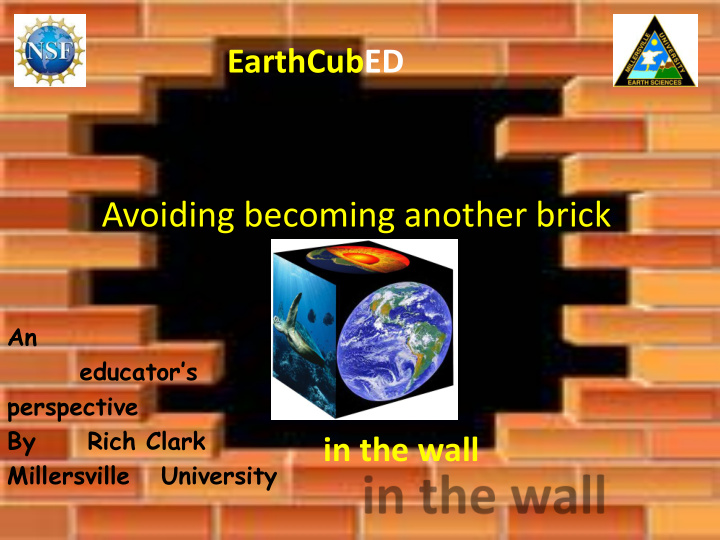



EarthCubED Avoiding becoming another brick An educator’s perspective By Rich Clark in the wall Millersville University
The EarthCube Drivers 1) Understanding and forecasting the behavior of a complex and evolving Earth system; 2) Reducing vulnerability and sustaining life; 3) Growing the geosciences workforce of the future.
From 30,000 feet; What is EarthCube? An open, adaptable and sustainable framework with an agile and robust geosciences-integrating architecture, with an inclusive governance paradigm, that will enable transformative research and education “Less Likely to be transformative if the system is not coupled with education and workforce development resources for the Earth science community” “New students will be able to directly access and visualize the data and start working on its scientific content, rather than fight with obscure data formats and portals.” Will EarthCube empower them? Sustainability depends on their buy-in
EarthCube Features Opportunities for learning and discovery Search across multiple granularity levels & disciplines for workflows Dataset and Workflow Discovery and datasets ; visualize on-demand strategy Commenting, annotating, rating, and categorization of workflows, Metadata for Workflow and Data Sets data sets, or models Data Security and Trust Ability for users to track data that needs further explanation Deliver data in user-requested format and translation between Data Access Services standards; Real-time access to data and facilities even in low bandwidth settings Workflow Execution Management Combine components from multiple existing workflow systems Data Management within Workflows Data Management within Workflows The ability to compose and integrate models or to extend models Modeling Standards and Frameworks into scientific workflows Intelligent data query, retrieval, download and interaction; Modeling Capabilities within Cloud, Grid, HPC, and science portals Interacting gridding/regridding, visualization and other manipulation and analysis tools; Real-time simulation capabilities Numerical Methods and Software Engineering Experimental facilities and data for model validation Tools to Probe, Validate, Verify, and Visualize Data Data mining tools and techniques; easy access to visualization tools Lower barrier to participation and mechanisms to ensure Broad Participation: Enable Collaboration and Participation from individual/small voices are heard; Outreach to encourage new International, Industry, Academic, NGO and other Domain Partners collaborations Best Practices & Governance Models for the Development of Standards and best practices for formal data publication and citation Definitions & Standards Policy Enforcement Processes Consensus driven decision making Continuity, Sustainability, & Evolution Social networking sites to support knowledge sharing between disparate teams
Use case Erica wants to study the relationship between gas prices at the pump and EPA criteria trace gas concentrations in major U.S. cities. In particular, how does summer 2008, with gas prices at $4.50/gal and 79 billion (3.5%) fewer miles driven, compare with summers with lower gas prices in terms of urban pollution? It took Erica over a year to gather disparate data sets and analysis tools.
Enter myEarthCube to access Erica grid-enable web services NCEP MODEL OUTPUT Intelligent data/info query Correlation between vehicle miles driven and air quality in the U.S. Tools to Probe/mine, Validate, Erica Dolinar CPC SEASONAL Scientific Verify, and Visualize Data Department of Earth Sciences, Millersville University, Millersville, PA T, precip, Literature anomalies Data Access Services In recent years, the United States has experienced an increase in gas prices and consequently a decrease in vehicle miles driven. From January through September 2008, Americans drove 79 billion fewer miles create a workflow as compared to the same period in 2007. This study focuses on the hypothesis that a reduction in EPA Emissions vehicle miles of this magnitude should be correlated with a signature in surface air quality? Ozone and Data Management within PM2.5 levels are examined in both years to determine if there is a direct correlation between the Data Workflows amount of miles traveled and of those pollutants. Meteorological fields are incorporated to attempt to normalize the differences in pollutant concentration due to weather influences. Preliminary results suggest that the signature of a decline in Ozone and PM2.5 is apparent in the data. Results point to Visualization and other greater, self-imposed, conservation during times of high gas prices lead to cleaner air. This poster will Transportation manipulation and analysis report on the methods of data reduction and analysis, with an emphasis on understanding whether the Data differences are indeed the result of fewer emissions or a consequence of differences in weather tools patterns between the two years. Publishing services EPA Criteria Gas Monitor Data
Use Case Ricardo wants to explore a model domain using a probe that allows him to monitor the changes in atmospheric variables as he navigates along various isosurfaces. His query in EarthCube space exposes a GUI – a front-end plug-in for IDV, that will allow him to do this.
Some EarthCubED requirements • Education and workforce professional development embedded like a fluid inclusion in every facet of the EarthCube • Students (users) need a workspace within EarthCube to play, explore, access, inquire, analyze, visualize, discover… – Date mining, phenomenon extraction, visualize on-demand, analysis tools, available for inquiry-based discovery • Each component of a workflow should have an instructional component – a mouse-over the service application to reveal a description, provenance, etc., and a click will show layers of association, and a learning exercise • A cluster of interconnections defined around a scientific article or scientific question reveals data sources, analysis methods, etc. (e.g. GEON) • Front-ends (GUIs) that can be designed to offer users unique visualization and analysis perspectives • Scientific questions can be posed and shared within a common repository, linked to data/information sources
We have (prediction systems, observations of all types and formats, DA methods, …, a dozen of best practice ITRs (LEAD, GEON, NEES, BIRN, NanoHub, ServoGrid …and commercial web services) It is more important that we imagine what can be, what are our needs, constraints, and challenges, and how EarthCube can facilitate, e mpower, and enable sailing on the “sea of data”
Recommend
More recommend